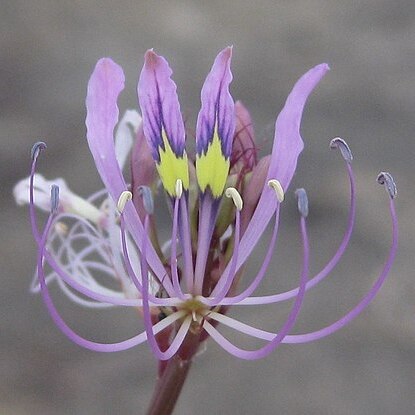Annual or short-lived perennial herb, well branched, up to 1.5 m. tall, viscid.. Stem densely covered with glandular hairs and stalked glands.. Leaves petiolate, 5–7(–9)-foliolate; leaflets linear or narrowly linear-elliptic, l–5(–9) cm. long, 1–4 mm. wide, with the margin sometimes uneven, sparsely to densely glandular-hairy; petiole 0.5–6 cm. long.. Inflorescence 10–30 cm. or more long; bracts leafy, but mostly much smaller than the leaves.. Sepals linear, 4–6(–8) mm. long, usually glandular.. Petals 1–1.8 cm. long, magenta, mauve, purple or pink.. Stamens (6–8–)10–12; filaments glandular, at least at the base.. Gynophore 4–15 mm. long, commonly shorter than the pedicel.. Capsules 6–12 cm. long, glandular.. Seeds ± 2 mm. in diameter, glabrous, with fine longitudinal striations and irregular, usually pronounced transverse ridges.. Fig. 2/4, p. 10.
Leaves 5–7–9-foliolate, on glandular, hairy petioles up to 7 cm. long but often less: leaflets 0.5–5.5 x 0.05–0.5 cm., linear, linear-lanceolate or narrowly oblong-lanceolate, subacute or rounded at the apex, cuneate at the base, glandular-hairy on both sides or sometimes glabrescent, decreasing in size upwards and passing into the sessile bracts which are commonly 3-foliolate but occasionally simple or 5-foliolate.
A small herb. It grows 1 m high. The branches have lines along them. They are hairy. The leaves have 5-9 small leaflets. It is sticky to the touch. The leaflets are 1-5 cm long by 0.1-0.5 cm wide. They are narrow and sword shaped. They are wedge shaped at the base. The flower are at the top. The petals are pink or purple. The fruit is a capsule 16 cm long by 0.4 cm wide. The seeds are about 2 mm across.
Erect herb, up to 500 mm tall. Stems viscid glandular-hirsute. Leaves 5-9-foliolate. Petals clawed, at least 2 median petals with yellow band across middle. Capsule 90-150 mm long. Flowers pink to purple.
Capsule up to 16 x 0.4 cm., linear, on a glandular gynophore 0.5–2.0 cm. long; valves glandular-pubescent or glabrescent, with 7–9 anastomosing, longitudinal nerves; persistent style 3–5 mm. long.
Petals up to 1.9 x 0.4 cm., purplish or pink, paler towards the base, with a lanceolate-oblong lamina rounded at the apex and with a distinct basal claw from 1/3 to almost as long as the lamina.
Stamens 10–12, filaments up to c. 2.5 cm. long, purplish, very slender, often glandular-pubescent towards the base, exserted; anther-thecae c. 2 mm. long, linear-oblong.
Inflorescence a terminal raceme which is moderately dense at first but eventually becomes greatly elongated in fruit; pedicels slender, glandular-pubescent.
Ovary linear, glandular-pubescent, with a short, glandular gynophore c. 2 mm. long even when young; style c. 2 mm. long, glabrous; stigma subcapitate.
Seeds 2––2.5 mm. in diam., transversely tuberculate-rugose with a very minute, mealy-glandular pubescence visible at a x 40 magnification.
Coarse, aromatic, viscid, erect herb up to 1.6 m. tall; branches striate, pubescent with gland-tipped hairs.
Sepals up to 1.2 cm. long, linear, subulate towards the apex, glandular-hairy outside.

